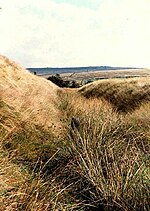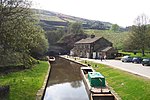Castleshaw
Geography of the Metropolitan Borough of OldhamGreater Manchester geography stubsSaddleworthTowns and villages of the Peak DistrictUse British English from February 2015 ... and 1 more
Villages in Greater Manchester

Castleshaw is a hamlet in the Saddleworth parish of the Metropolitan Borough of Oldham in Greater Manchester, England. It lies amid the Pennines, 2.4 miles (3.9 km) north of Uppermill, 3 miles (4.8 km) west-southwest of Marsden, and 5.3 miles (8.5 km) east-northeast of Oldham. Historically a part of the West Riding of Yorkshire, Castleshaw is most notable for the Castleshaw Roman fort, the remains of an ancient castrum. There are two reservoirs, Castleshaw upper reservoir and Castleshaw lower reservoir. In 2016, United Utilities reinforced the walls on the lower reservoir but had to drop water levels by 1m.
Excerpt from the Wikipedia article Castleshaw (License: CC BY-SA 3.0, Authors, Images).Castleshaw
Bleak Hey Nook Lane,
Geographical coordinates (GPS) Address Nearby Places Show on map
Geographical coordinates (GPS)
| Latitude | Longitude |
|---|---|
| N 53.583 ° | E -1.999 ° |
Address
Bleak Hey Nook Lane
Bleak Hey Nook Lane
OL3 5LY , Saddleworth
England, United Kingdom
Open on Google Maps









